Sustainability Assessment of Urban Waterscape Belt Ecological Reconstruction Based on LCA–Emergy–Carbon Emission Methodology
Abstract
:1. Introduction
1.1. Background
1.2. Literature Review
1.2.1. Emergy Method
1.2.2. LCA–Emergy
1.2.3. Carbon Emissions of Building Systems
1.3. Motivations, Innovations, and Contributions
2. Material and Methods
2.1. Research Framework
2.2. LCA–Emergy Model
2.2.1. Emergy Introduction
2.2.2. LCA–Emergy
2.2.3. Emergy Diagram
2.2.4. Emergy Indicators
- (1)
- Environmental loading ratio (EIR)
- (2)
- Emergy yield ratio (EYR)
- (3)
- Emergy sustainability indicator (ESI)
- (4)
- Unit emergy values (UEVs)
2.2.5. Sensitivity Analysis
- (1)
- Hypothesis model A: 10% of the underlying data will be adjusted, and then the changes in three key indicators (ELR/EYR/ESI) will be checked.
- (2)
- Hypothesis model B: 8% of the basic indicators for data adjustment, to verify the floating of three critical indicators (ELR/EYR/ESI).
- (3)
- Hypothesis model C: the basic data will be considered with a 5% float. After calculation, the floating range of the index group will be verified.
- (4)
- Hypothesis model D: a smaller data float (3%) will be performed, and sensitivity analysis will show the sensitivity precision on the basis of a diminutive range variation.
2.3. LCA–Carbon Calculation Model
- (1)
- Natural carbon sink system implementation path
- Soil type method calculation modelAverage organic carbon in each area unit:where is soil weight; is the average organic carbon storage; is soil thickness; and is the average gravel content.Total soil organic carbon of regional area:where is the area of a grid cell, is the unit mean organic carbon density, and n is the total soil area grid units.
- Life zone method computational modelRelationship between the density and depth of soil organic carbon:where is soil weight; b1, b2, b3 are constants of soil weight and carbon density under different vegetation types; D is the depth from the surface to the center of the soil layer; and Cf is the organic carbon mass fraction.The average carbon density of layers per unit area:where is the gravel fraction; V is soil layer volume.
- Estimation model of remote sensing technology methodThe total amount of carbon in all types of soil:where i is soil type; is soil organic carbon storage (t); 0.58 is the carbon storage conversion factor; is soil area; is mean soil thickness; is average mass fraction of soil organic matter; and is average soil weight.
- (2)
- Artificial carbon sink system implementation pathBuilding materials with carbon adsorption are mainly concentrated in concrete materials, mortar, and non-metallic oxides, among which concrete materials are the main channel of carbon sinks. The carbonization process involves temperature, humidity, exposure conditions, porosity, water–cement ratio, strength grade, ambient CO2 concentration, surface coatings, and other complex factors.
- Classical concrete carbonation theory estimation model
where d is the concrete carbonation depth; is the effective diffusion coefficient of carbon dioxide in concrete; is the concentration of the concrete surface; is carbon dioxide absorption per unit volume of concrete; and t is the carbonization time.- Molecular level carbonization theory estimation model
where is the initial concentration of each carbide-able substance; is the effective diffusion coefficient of carbon dioxide in concrete; and is the concentration of carbon dioxide on the concrete surface.- Carbonization estimation model based on water–cement ratio
The water–cement ratio is greater than 0.6,The water–cement ratio is less than 0.6,where is the water–cement ratio; is the influence coefficient of cement variety; is the aggregate variety influence coefficient; and is the influence coefficient of concrete admixture.- Carbonation estimation model based on compressive strength of concrete
where f is the standard compressive strength of concrete; k1 is the regional influence coefficient; k2 is indoor and outdoor influence coefficient; and k3 is the curing time coefficient of concrete.- Carbonization estimation model based on different material correction coefficients
where is the coefficient of concrete carbonation velocity; , , , , and are the influence coefficients of water–cement ratio, cement dosage, aggregate type, fly-ash-to-cement content ratio, curing method, and cement variety, respectively; and t is the carbonization time.- Carbonization estimation model for diffusion theory
where RH is ambient relative humidity; is water–cement ratio; C is cement dosage; and is the volume fraction of carbon dioxide.
3. Case Study
3.1. Case Introduction
3.2. Data Collection
4. Results and Discussion
4.1. LCA–Emergy Analysis
4.1.1. Dominated Contributor
4.1.2. Emergy Indexes Analysis
4.1.3. Sensitivity Analysis
4.1.4. Unit Emergy Values (UEVs)
4.2. LCA–Carbon Emission Analysis
4.2.1. The Carbon Emission Analysis of Reconstruction Project 1
4.2.2. The Carbon Emission Comparative Analysis of Reconstruction Projects 1 to 4
4.2.3. Carbon Sink Analysis
4.3. Comparison with Existing Research Progress
5. Clean Energy Improvement Strategy
6. Conclusions
Author Contributions
Funding
Institutional Review Board Statement
Informed Consent Statement
Data Availability Statement
Acknowledgments
Conflicts of Interest
Appendix A
| Types | Project 1 | Project 2 | Project 3 | Project 4 | Unit |
|---|---|---|---|---|---|
| Steel | 189.6 | 189.6 | 189.6 | 189.6 | tCO2 |
| Cement | 26.6 | 26.6 | 26.6 | 26.6 | tCO2 |
| Gravel | 129,600 | 107,200 | 44,800 | 102,400 | tCO2 |
| Brick | 9.8 | 9.8 | 9.8 | 9.8 | tCO2 |
| Lime | 316.8 | 316.8 | 316.8 | 316.8 | tCO2 |
| Sand | 13,052.0 | 9538 | 9538 | 9538 | tCO2 |
| Water | 516,600 | 729,800 | 282,900 | 395,240 | tCO2 |
| Iron | 43.1 | 43.1 | 43.1 | 43.1 | tCO2 |
| Wood | 1999.5 | 1999.5 | 1999.5 | 1999.5 | tCO2 |
| Polyester | 89.4 | 89.4 | 89.4 | 89.4 | tCO2 |
| Adhesive | 7.2 | 7.2 | 7.2 | 7.2 | tCO2 |
| Bituminous | 0.4 | 0.4 | 0.4 | 0.4 | tCO2 |
| Fly ash | 119.5 | 119.5 | 119.5 | 119.5 | tCO2 |
| PVC | 33.3 | 33.3 | 33.3 | 33.3 | tCO2 |
| Diesel fuel | 253.8 | 253.8 | 253.8 | 253.8 | tCO2 |
References
- Beck, D.; Ferasso, M. Bridging ‘Stakeholder Value Creation’ and ‘Urban Sustainability’: The need for better integrating the Environmental Dimension. Sustain. Cities Soc. 2023, 89, 104316. [Google Scholar] [CrossRef]
- Hao, Z.; Wang, Y. Evaluation of socio-economic-ecological environmental benefits of urban renewal projects based on the coupling coordination degree. Environ. Sci. Pollut. Res. 2023, 30, 56946–56968. [Google Scholar] [CrossRef] [PubMed]
- Li, D.; Yan, S.; Chen, G. Effects of Urban Redevelopment on Surface Urban Heat Island. IEEE J. Sel. Top. Appl. Earth Obs. Remote Sens. 2023, 16, 2366–2373. [Google Scholar] [CrossRef]
- Ramsay, E.E.; Duffy, G.A.; Burge, K.; Taruc, R.R.; Fleming, G.M.; Faber, P.A.; Chown, S.L. Spatio-temporal development of the urban heat island in a socioeconomically diverse tropical city. Environ. Pollut. 2023, 316, 120443. [Google Scholar] [CrossRef] [PubMed]
- Odum, H.T. Environmental Accounting: Emergy and Environmental Decision Making; John and Wiley and Sons: Hoboken, NJ, USA, 1996; pp. 32–34. [Google Scholar]
- Mufan, Z.; Yong, G.; Hengyu, P.; Fei, W.; Dong, W. Ecological and socioeconomic impacts of payments for ecosystem services—A Chinese garlic farm case. J. Clean. Prod. 2021, 285, 124866. [Google Scholar] [CrossRef]
- Asgharipour, M.R.; Amiri, Z.; Campbell, D.E. Evaluation of the sustainability of four greenhouse vegetable production ecosystems based on an analysis of emergy and social characteristics. Ecol. Model. 2020, 424, 109021. [Google Scholar] [CrossRef]
- Bergquist, D.; Garcia-Caro, D.; Joosse, S.; Granvik, M.; Peniche, F. The Sustainability of Living in a “Green” Urban District: An Emergy Perspective. Sustainability 2020, 12, 5661. [Google Scholar] [CrossRef]
- Zhang, J.; Ma, L. Urban ecological security dynamic analysis based on an innovative emergy ecological footprint method. Environ. Dev. Sustain. 2021, 23, 16163–16191. [Google Scholar] [CrossRef]
- Santagata, R.; Zucaro, A.; Fiorentino, G.; Lucagnano, E.; Ulgiati, S. Developing a procedure for the integration of Life Cycle Assessment and Emergy Accounting approaches. The Amalfi paper case study. Ecol. Indic. 2020, 117, 106676. [Google Scholar] [CrossRef]
- Zhang, J.; Zhang, H.; Asutosh, A.T.; Sun, N.; Fu, X.; Wang, H.; Li, X. Ecological sustainability assessment of building glass industry in China based on the point of view of raw material emergy and chemical composition. Environ. Sci. Pollut. Res. 2023, 30, 40670–40697. [Google Scholar] [CrossRef] [PubMed]
- Cristiano, S.; Gonella, F. To build or not to build? Megaprojects, resources, and environment: An emergy synthesis for a systemic evaluation of a major highway expansion. J. Clean. Prod. 2019, 223, 772–789. [Google Scholar] [CrossRef]
- Yadegaridehkordi, E.; Hourmand, M.; Nilashi, M.; Alsolami, E.; Samad, S.; Mahmoud, M.; Alarood, A.A.; Zainol, A.; Majeed, H.D.; Shuib, L. Assessment of sustainability indicators for green building manufacturing using fuzzy multi-criteria decision making approach. J. Clean. Prod. 2020, 277, 122905. [Google Scholar] [CrossRef]
- Yang, L.; Wang, C.; Yu, H.; Yang, M.; Wang, S.; Chiu, A.S.; Wang, Y. Can an island economy be more sustainable? A comparative study of Indonesia, Malaysia, and the Philippines. J. Clean. Prod. 2019, 242, 118572. [Google Scholar] [CrossRef]
- Wang, X.; Liu, G.; Coscieme, L.; Giannetti, B.F.; Hao, Y.; Zhang, Y.; Brown, M.T. Study on the emergy-based thermodynamic geography of the Jing-Jin-Ji region: Combined multivariate statistical data with DMSP-OLS nighttime lights data. Ecol. Model. 2019, 397, 1–15. [Google Scholar] [CrossRef]
- Lee, D.J.; Brown, M.T. Estimating the Value of Global Ecosystem Structure and Productivity: A Geographic Information System and Emergy Based Approach. Ecol. Model. 2020, 439, 109307. [Google Scholar] [CrossRef]
- Fan, Y.; Meng, J.; Ye, H.; Wang, P.; Wang, Y.; Wang, Y. Sustainability and ecological efficiency of low-carbon power system: A concentrating solar power plant in China. J. Environ. Manag. 2021, 290, 112659. [Google Scholar] [CrossRef] [PubMed]
- Hou, M.; Braham, W.W. Land development in an urban megalopolis: A holistic environmental assessment of housing on Chongming Eco-island, China. J. Clean. Prod. 2021, 312, 127617. [Google Scholar] [CrossRef]
- Xie, B.; Zhang, X.; Lu, J.; Liu, F.; Fan, Y. Research on ecological evaluation of Shanghai port logistics based on emergy ecological footprint models. Ecol. Indic. 2022, 139, 108916. [Google Scholar] [CrossRef]
- Du, Y.-W.; Wang, Y.-C.; Li, W.-S. Emergy ecological footprint method considering uncertainty and its application in evaluating marine ranching resources and environmental carrying capacity. J. Clean. Prod. 2022, 336, 130363. [Google Scholar] [CrossRef]
- Zadehdabagh, N.; Monavari, S.M.; Kargari, N.; Taghavi, L.; Pirasteh, S. Sustainability of agroecosystems by indices: A comparative study between indicators of ecological footprint sustainability and emergy analysis; a case study in Dez catchment, Iran. Ecol. Model. 2022, 474, 110165. [Google Scholar] [CrossRef]
- Chen, X.; Wang, H.; Zhang, J.; Zhang, H.; Asutosh, A.T.; Wu, G.; Wei, G.; Shi, Y.; Yang, M. Sustainability Study of a Residential Building near Subway Based on LCA-Emergy Method. Buildings 2022, 12, 679. [Google Scholar] [CrossRef]
- Wang, Y.; Liu, G.; Cai, Y.; Giannetti, B.F.; Agostinho, F.; Almeida, C.M.V.B.; Casazza, M. The Ecological Value of Typical Agricultural Products: An Emergy-Based Life-Cycle Assessment Framework. Front. Environ. Sci. 2022, 10, 824275. [Google Scholar] [CrossRef]
- Tam, V.W.; Zhou, Y.; Illankoon, C.; Le, K.N. A critical review on BIM and LCA integration using the ISO 14040 framework. Build. Environ. 2022, 213, 108865. [Google Scholar] [CrossRef]
- Xu, J.; Teng, Y.; Pan, W.; Zhang, Y. BIM-integrated LCA to automate embodied carbon assessment of prefabricated buildings. J. Clean. Prod. 2022, 374, 133894. [Google Scholar] [CrossRef]
- Teng, Y.; Xu, J.; Pan, W.; Zhang, Y. A systematic review of the integration of building information modeling into life cycle assessment. Build. Environ. 2022, 221, 109260. [Google Scholar] [CrossRef]
- Hassan, S.R.; Megahed, N.A.; Eleinen, O.M.A.; Hassan, A.M. Toward a national life cycle assessment tool: Generative design for early decision support. Energy Build. 2022, 267, 112144. [Google Scholar] [CrossRef]
- Fnais, A.; Rezgui, Y.; Petri, I.; Beach, T.; Yeung, J.; Ghoroghi, A.; Kubicki, S. The application of life cycle assessment in buildings: Challenges, and directions for future research. Int. J. Life Cycle Assess. 2022, 27, 627–654. [Google Scholar] [CrossRef]
- Larsen, V.G.; Tollin, N.; Sattrup, P.A.; Birkved, M.; Holmboe, T. What are the challenges in assessing circular economy for the built environment? A literature review on integrating LCA, LCC and S-LCA in life cycle sustainability assessment, LCSA. J. Build. Eng. 2022, 50, 104203. [Google Scholar] [CrossRef]
- Cui, W.; Hong, J.; Liu, G.; Li, K.; Huang, Y.; Zhang, L. Co-Benefifits Analysis of Buildings Based on Different Renewal Strategies: The Emergy-Lca Approach. Int. J. Environ. Res. Public Health 2021, 18, 592. [Google Scholar] [CrossRef]
- Hu, S.; Zhang, Y.; Yang, Z.; Yan, D.; Jiang, Y. Challenges and opportunities for carbon neutrality in China’s building sector—Modelling and data. Build. Simul. 2022, 15, 1899–1921. [Google Scholar] [CrossRef]
- Huo, T.; Xu, L.; Liu, B.; Cai, W.; Feng, W. China’s commercial building carbon emissions toward 2060: An integrated dynamic emission assessment model. Appl. Energy 2022, 325, 119828. [Google Scholar] [CrossRef]
- Zhang, N.; Luo, Z.; Liu, Y.; Feng, W.; Zhou, N.; Yang, L. Towards low-carbon cities through building-stock-level carbon emission analysis: A calculating and mapping method. Sustain. Cities Soc. 2022, 78, 103633. [Google Scholar] [CrossRef]
- Gan, L.; Liu, Y.; Shi, Q.; Cai, W.; Ren, H. Regional inequality in the carbon emission intensity of public buildings in China. Build. Environ. 2022, 225, 109657. [Google Scholar] [CrossRef]
- Wang, X.; Du, Q.; Lu, C.; Li, J. Exploration in carbon emission reduction effect of low-carbon practices in prefabricated building supply chain. J. Clean. Prod. 2022, 368, 133153. [Google Scholar] [CrossRef]
- Liu, W.; Zuo, B.; Qu, C.; Ge, L.; Shen, Q. A reasonable distribution of natural landscape: Utilizing green space and water bodies to reduce residential building carbon emissions. Energy Build. 2022, 267, 112150. [Google Scholar] [CrossRef]
- Amoruso, F.M.; Sonn, M.-H.; Schuetze, T. Carbon-neutral building renovation potential with passive house-certified components: Applications for an exemplary apartment building in the Republic of Korea. Build. Environ. 2022, 215, 108986. [Google Scholar] [CrossRef]
- Chen, C.; Bi, L. Study on spatio-temporal changes and driving factors of carbon emissions at the building operation stage—A case study of China. Build. Environ. 2022, 219, 109147. [Google Scholar] [CrossRef]
- Gan, L.; Ren, H.; Cai, W.; Wu, K.; Liu, Y.; Liu, Y. Allocation of carbon emission quotas for China’s provincial public buildings based on principles of equity and efficiency. Build. Environ. 2022, 216, 108994. [Google Scholar] [CrossRef]
- Grinham, J.; Fjeldheim, H.; Yan, B.; Helge, T.D.; Edwards, K.; Hegli, T.; Malkawi, A. Zero-carbon balance: The case of HouseZero. Build. Environ. 2021, 207, 108511. [Google Scholar] [CrossRef]
- Partridge, L.E.; Loughnane, E.J. Committed carbon-upgrading existing buildings. Struct. Des. Tall Spéc. Build. 2008, 17, 989–1002. [Google Scholar] [CrossRef]
- Nadoushani, Z.S.M.; Akbarnezhad, A. Effects of structural system on the life cycle carbon footprint of buildings. Energy Build. 2015, 102, 337–346. [Google Scholar] [CrossRef]
- Ioannidou, D.; Sonnemann, G.; Suh, S. Do we have enough natural sand for low-carbon infrastructure? J. Ind. Ecol. 2020, 24, 1004–1015. [Google Scholar] [CrossRef]
- Sheykhi, M.; Chahartaghi, M.; Hashemian, S.M. Performance Evaluation of a Combined Heat and Power System with Stirling Engine for Residential Applications. Iran. J. Sci. Technol. Trans. Mech. Eng. 2019, 44, 975–984. [Google Scholar] [CrossRef]
- Zhang, J.; Srinivasan, R.S.; Peng, C. A Systematic Approach to Calculate Unit Emergy Values of Cement Manufacturing in China Using Consumption Quota of Dry and Wet Raw Materials. Buildings 2020, 10, 128. [Google Scholar] [CrossRef]
- Zhang, J.; Srinivasan, R.S.; Peng, C. Ecological Assessment of Clay Brick Manufacturing in China Using Emergy Analysis. Buildings 2020, 10, 190. [Google Scholar] [CrossRef]
- Shi, T. Carbon Sequestration in Urban Ecosystem; China Architecture and Building Press: Beijing, China, 2022; Volume 6. [Google Scholar]
- Wu, H.; Fang, S.; Zhang, C.; Hu, S.; Nan, D.; Yang, Y. Exploring the impact of urban form on urban land use efficiency under low-carbon emission constraints: A case study in China’s Yellow River Basin. J. Environ. Manag. 2022, 311, 114866. [Google Scholar] [CrossRef]
- Liu, X.; Huang, J.; Liu, W.; Ding, Y.; Ge, L. Research on the Coastal Landscape Pattern Index in the District of Nansha. Sustainability 2023, 15, 3378. [Google Scholar] [CrossRef]
- Cheng, Q. Study of ecological water-demand security in the Linghekou Reserve of north-eastern China, based on landscape pattern. Mar. Freshw. Res. 2022. [CrossRef]
- Li, J. Water Environment Governance of Urban and Rural Spaces Integrating Natural Ecological Landscape Design Method. J. Environ. Public Health 2022, 2022, 3623141. [Google Scholar] [CrossRef]
- Cao, Z.; Wan, B.; Xiao, Y.; Wu, M.; Tan, X.; Zhang, Q.; Wang, D. Exploring the Impact of Landscape Ecological Risk on Water Quality in the Danjiangkou Reservoir, China. Earth Space Sci. 2022, 9, e2022EA002363. [Google Scholar] [CrossRef]
- Brown, M.T.; Campbell, D.E.; De Vilbiss, C.; Ulgiati, S. The geobiosphere emergy baseline: A synthesis. Ecol. Model. 2016, 339, 92–95. [Google Scholar] [CrossRef]
- Kim, S.K.; Park, S. Impacts of renewable energy on climate vulnerability: A global perspective for energy transition in a climate adaptation framework. Sci. Total Environ. 2023, 859, 160175. [Google Scholar] [CrossRef]
- Shang, Y.; Han, D.; Gozgor, G.; Mahalik, M.K.; Sahoo, B.K. The impact of climate policy uncertainty on renewable and non-renewable energy demand in the United States. Renew. Energy 2022, 197, 654–667. [Google Scholar] [CrossRef]
- Zhao, J.; Dong, K.; Dong, X.; Shahbaz, M. How renewable energy alleviate energy poverty? A global analysis. Renew. Energy 2022, 186, 299–311. [Google Scholar] [CrossRef]
- Chu, L.K. The role of energy security and economic complexity in renewable energy development: Evidence from G7 countries. Environ. Sci. Pollut. Res. 2023, 30, 56073–56093. [Google Scholar] [CrossRef] [PubMed]
- Ji, M.; Zhang, W.; Xu, Y.; Liao, Q.; Klemeš, J.J.; Wang, B. Optimisation of multi-period renewable energy systems with hydrogen and battery energy storage: A P-graph approach. Energy Convers. Manag. 2023, 281, 116826. [Google Scholar] [CrossRef]
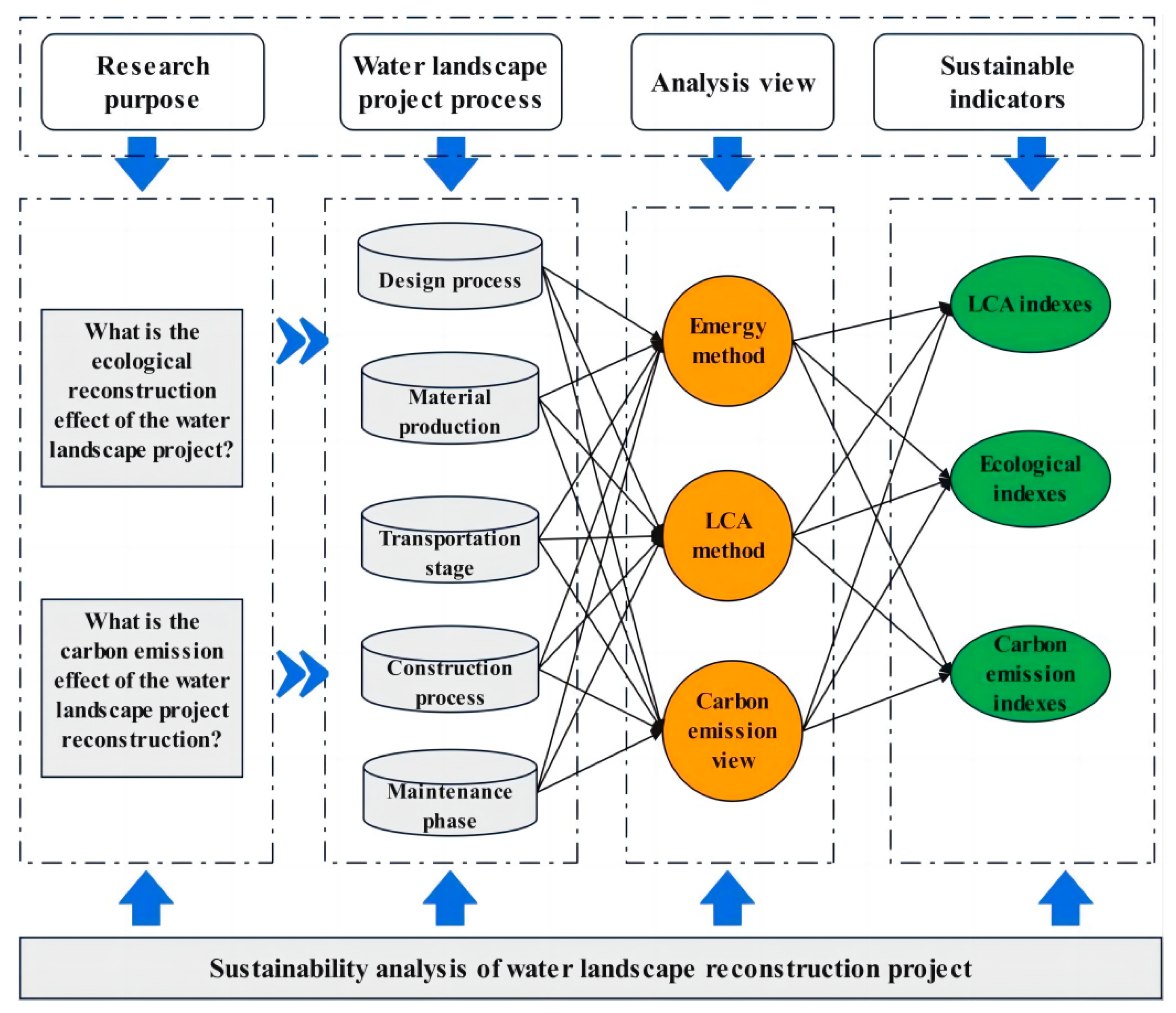
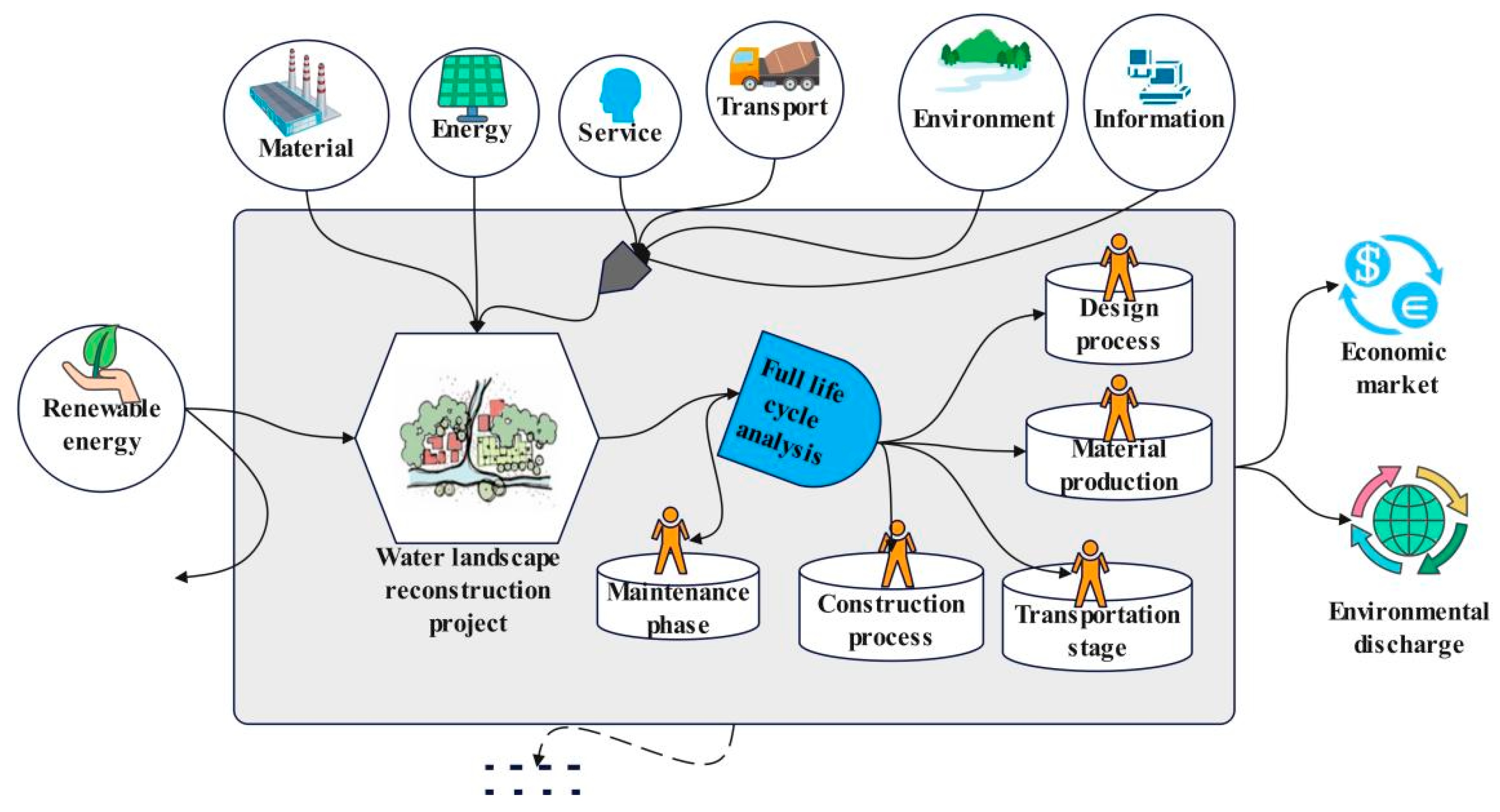
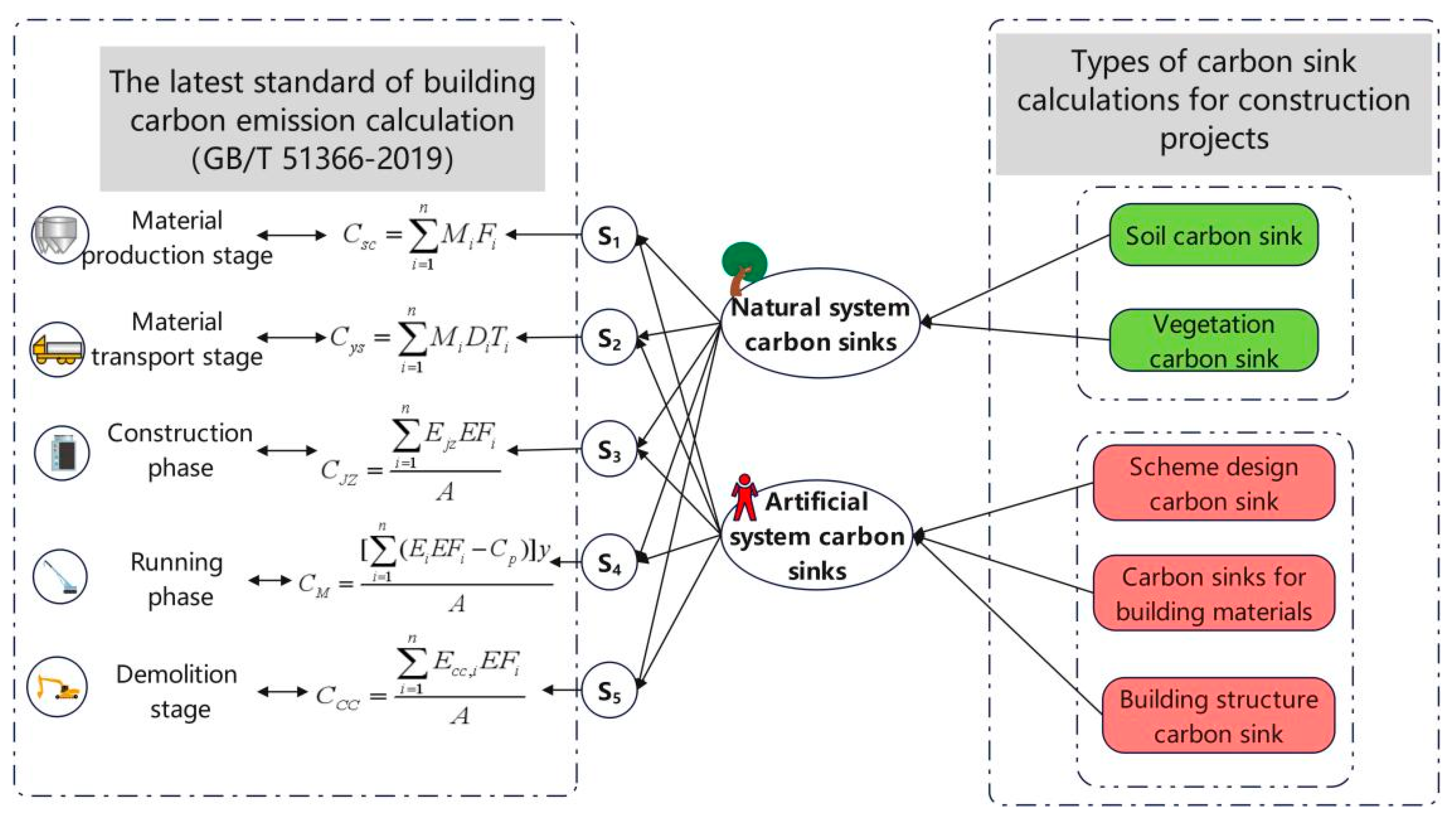


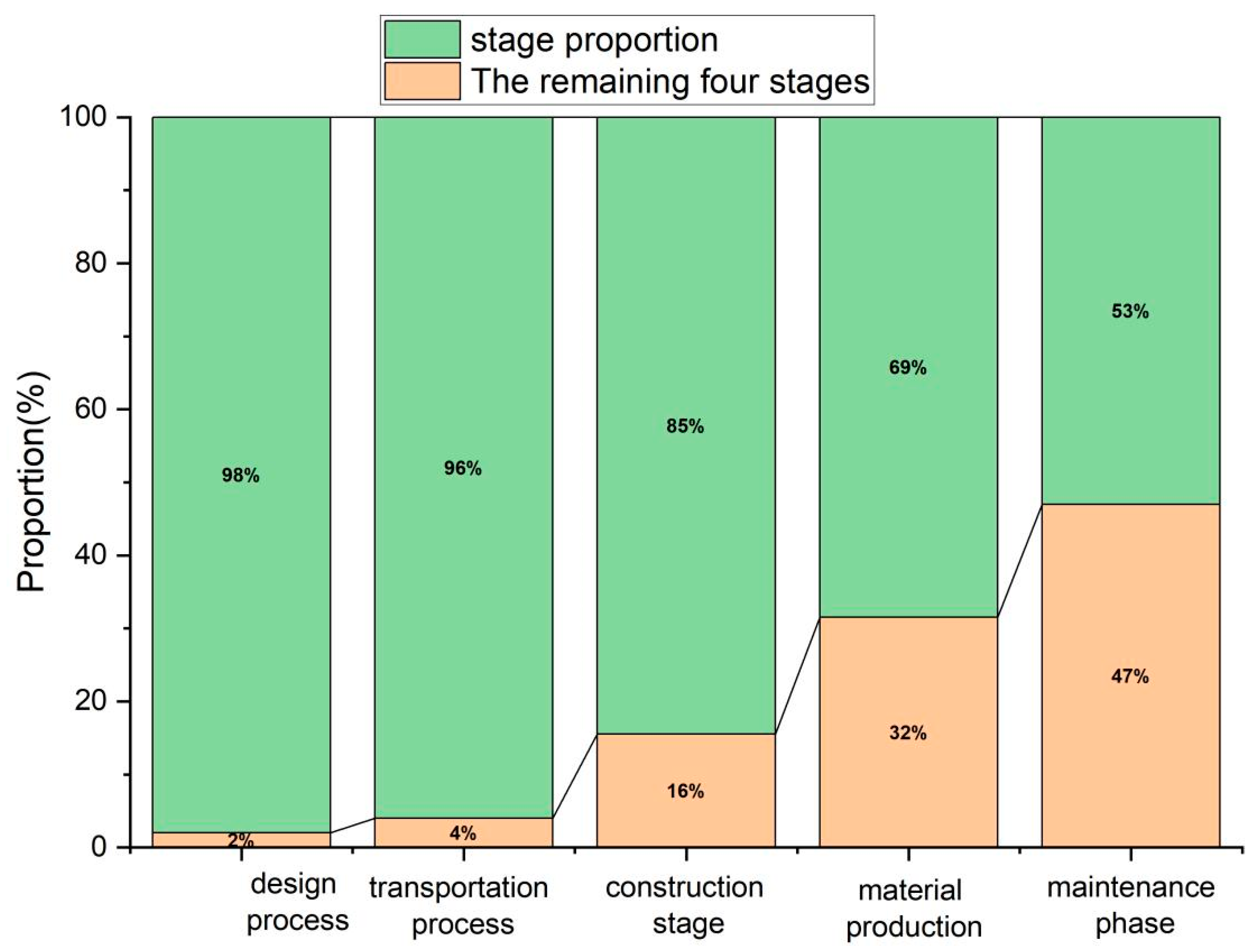

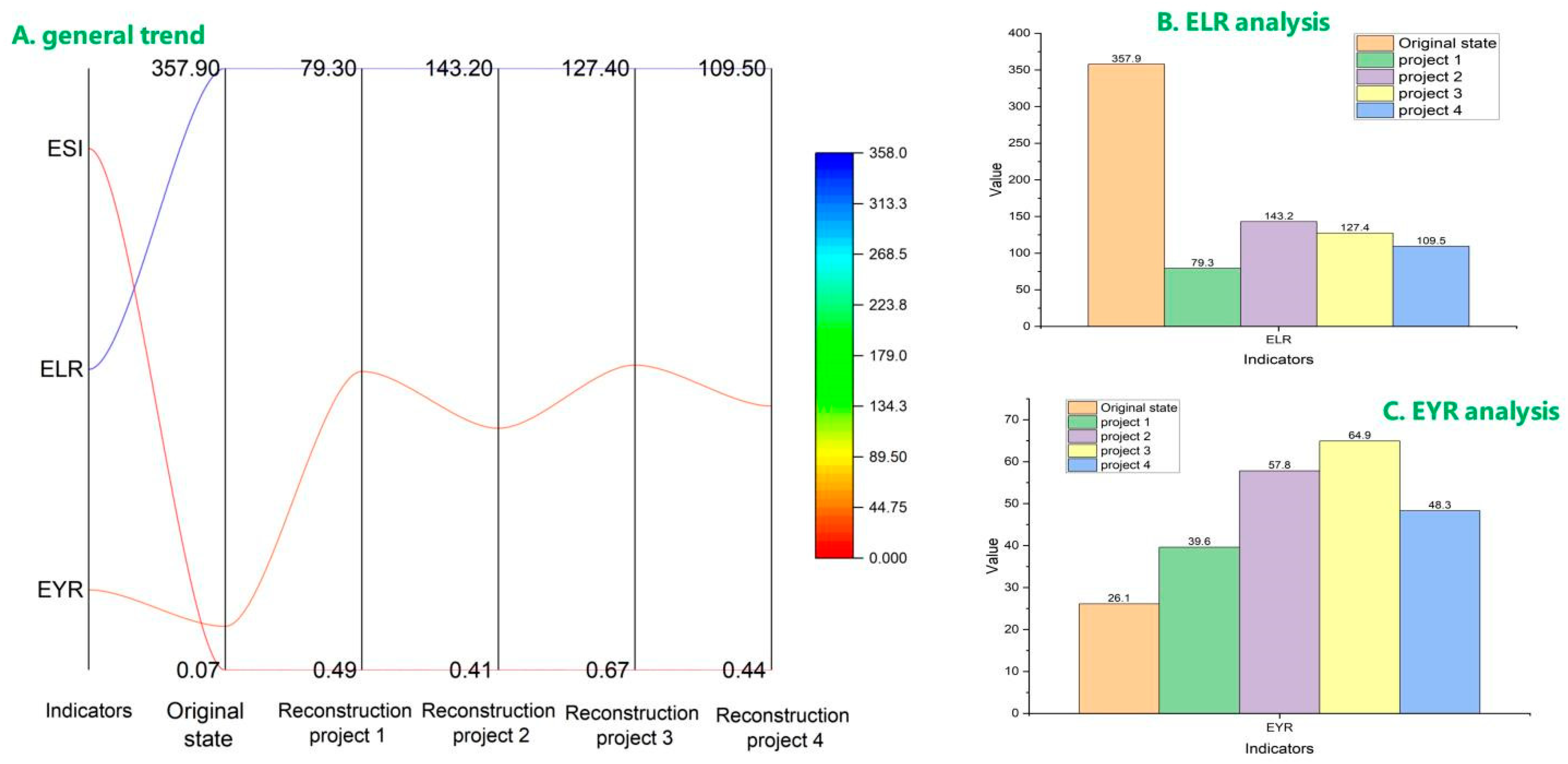


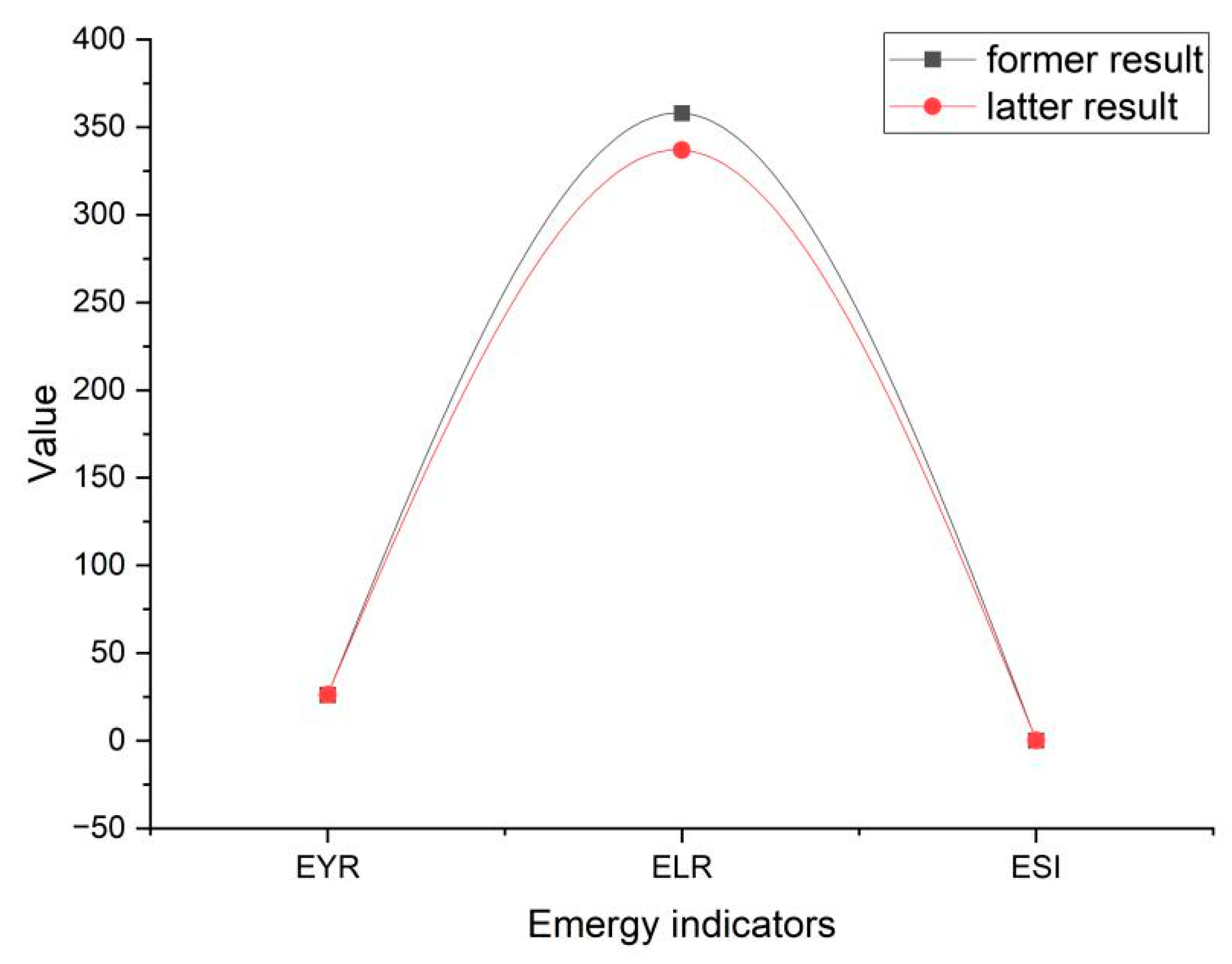
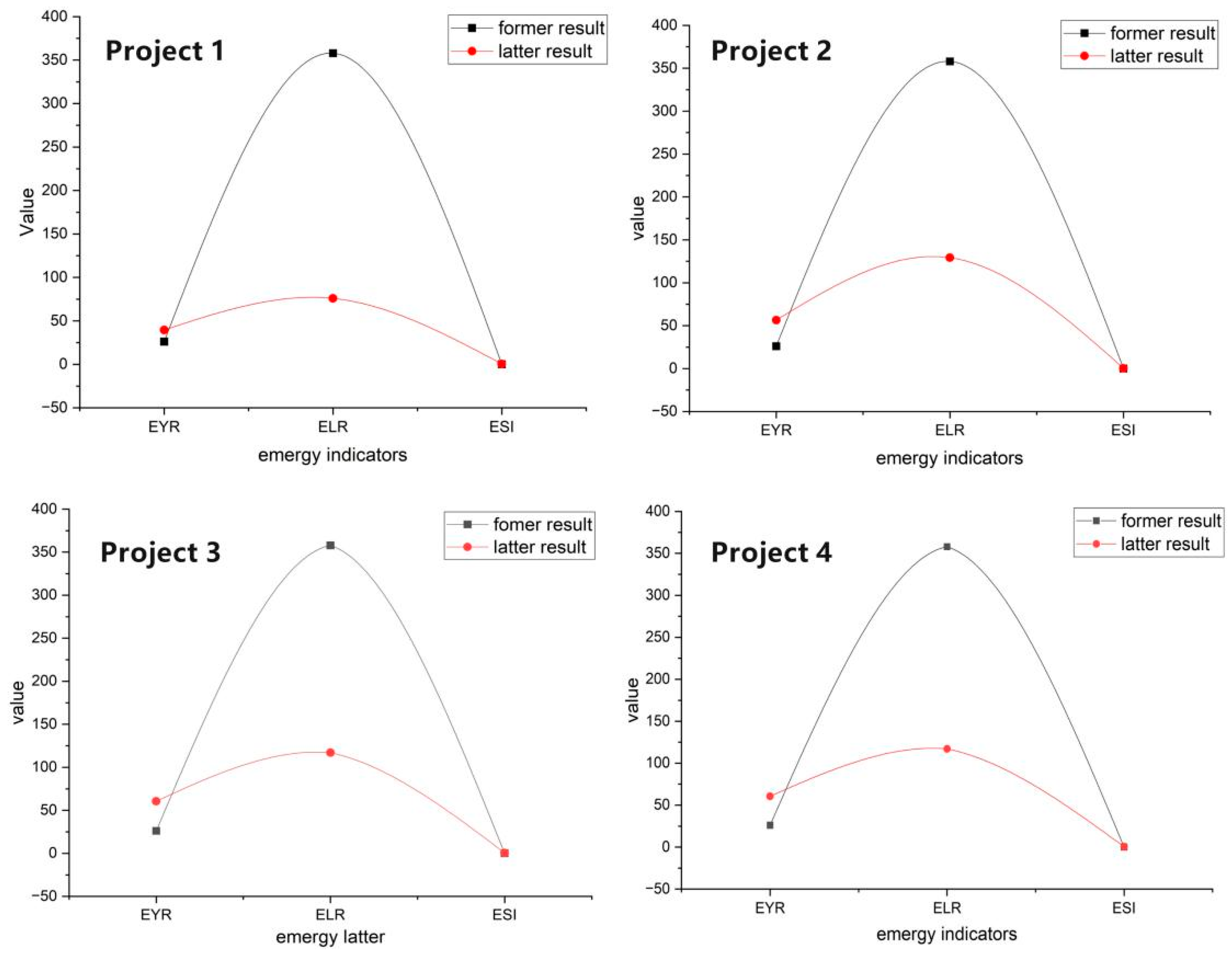
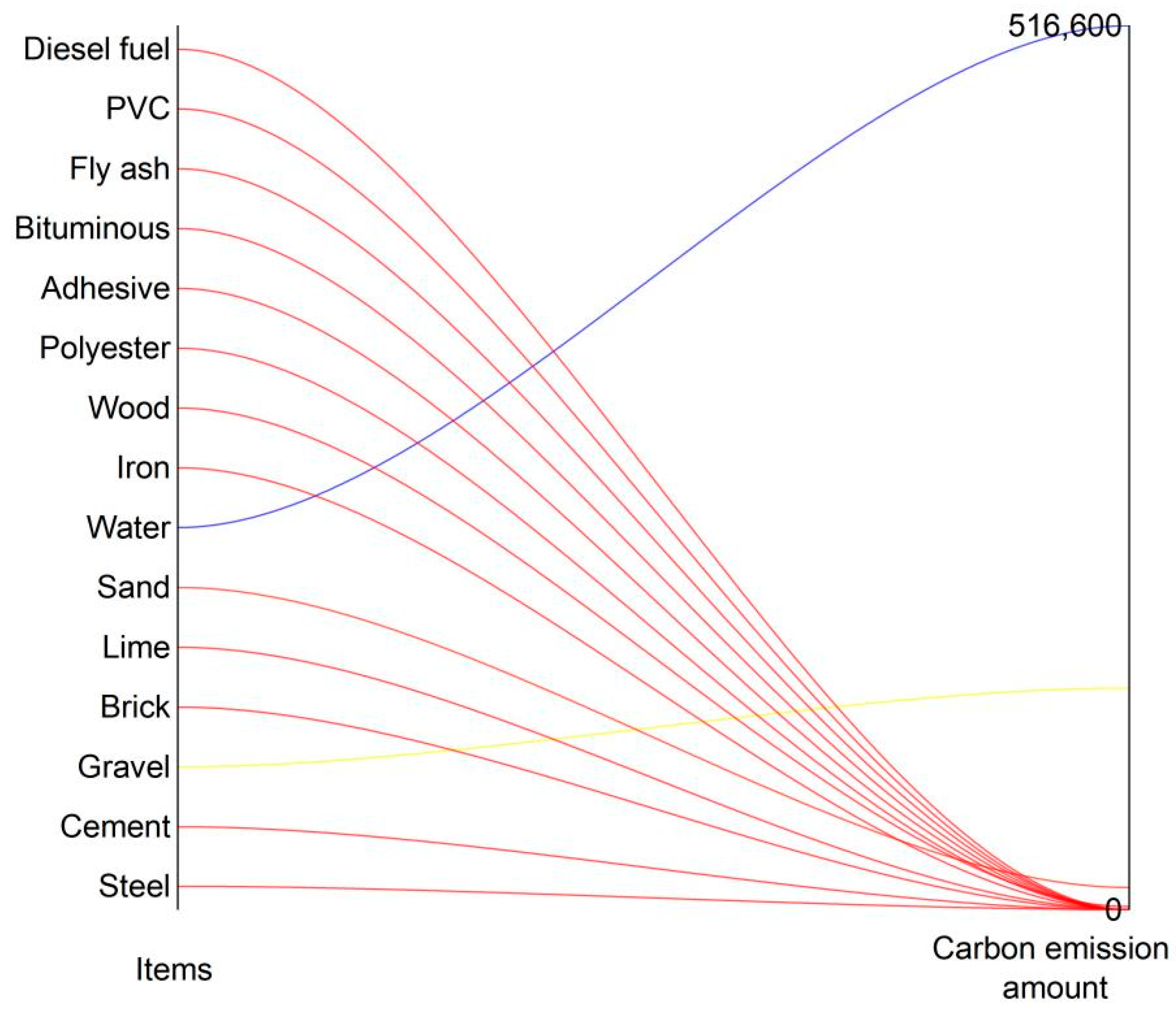


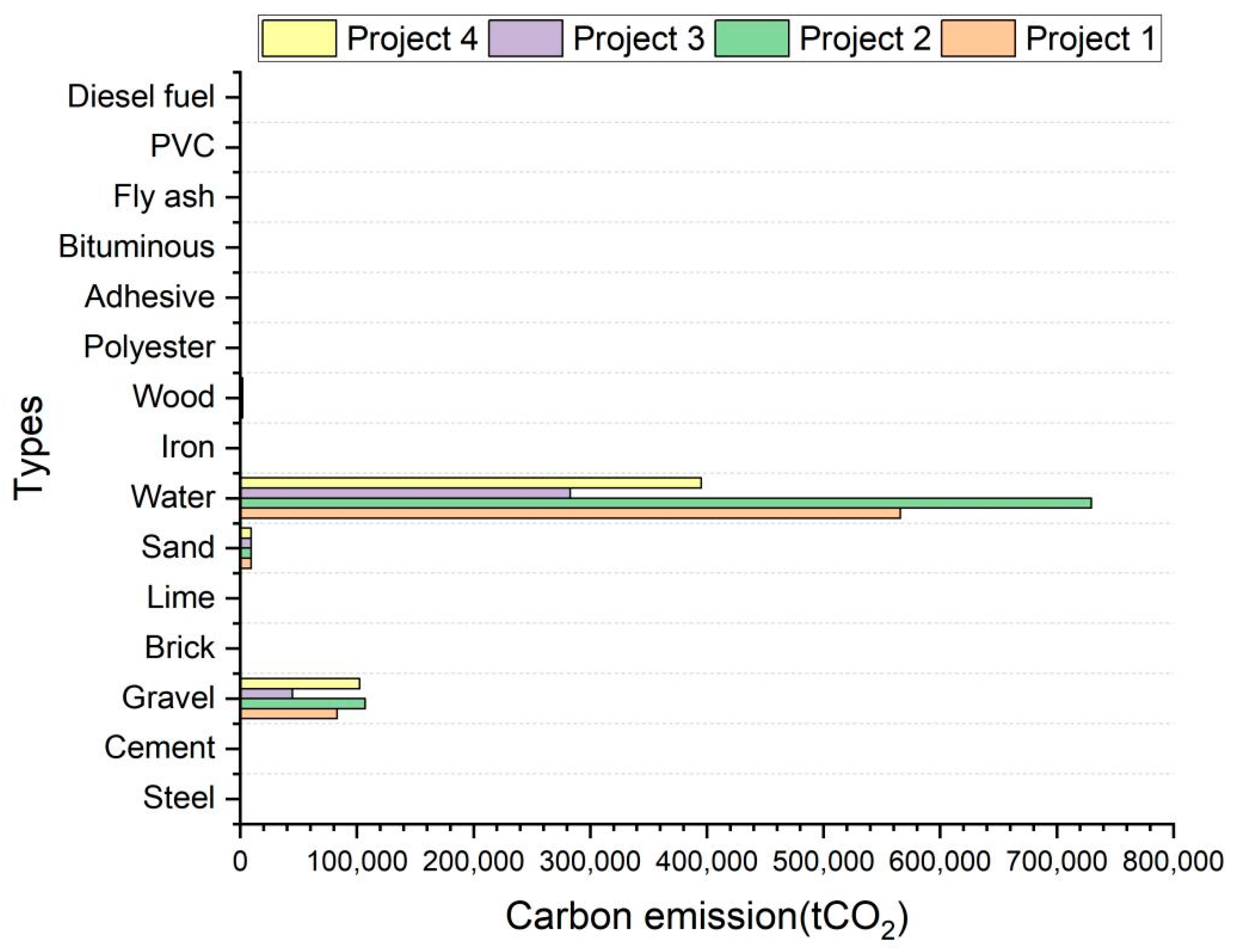
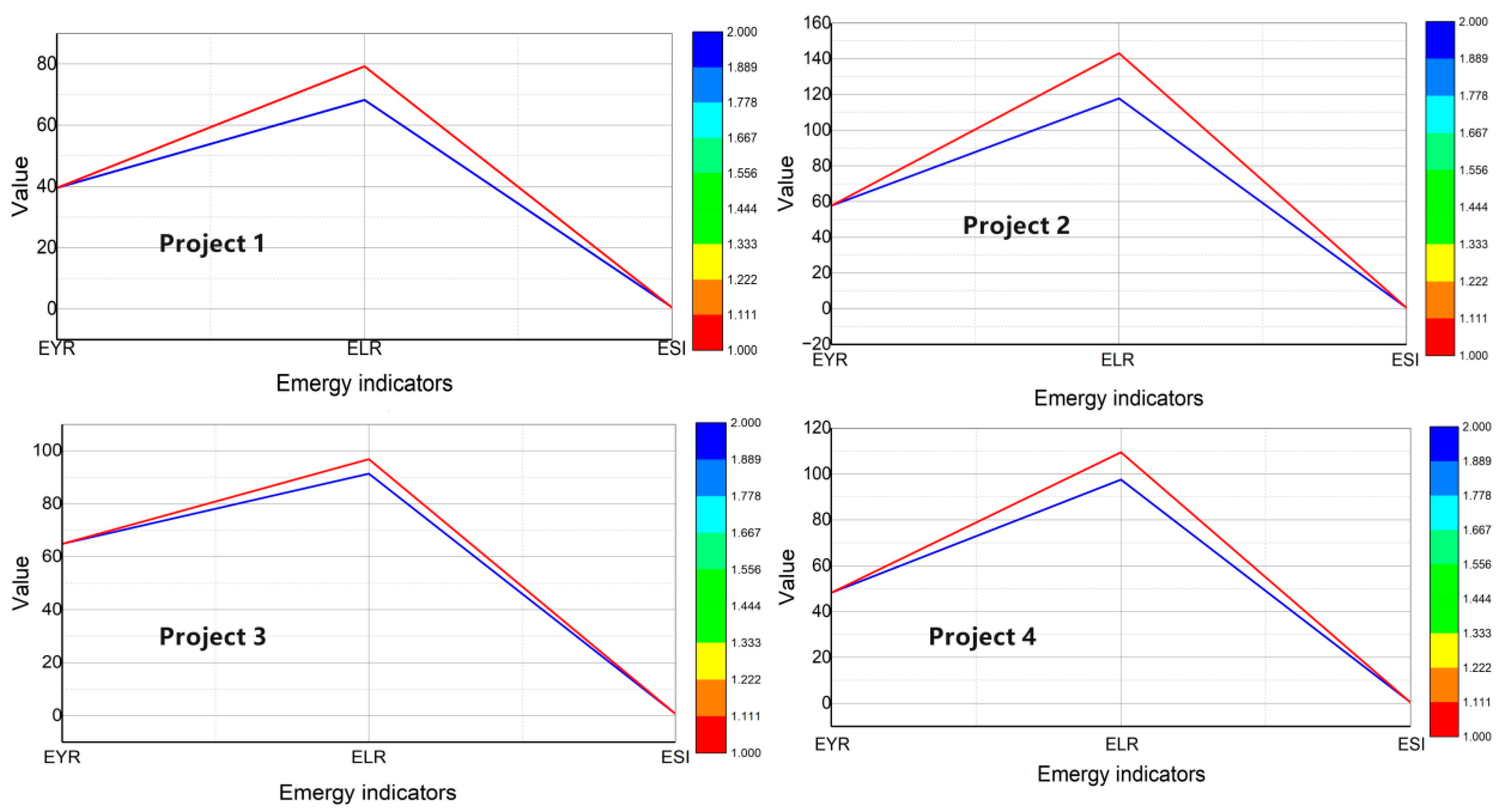
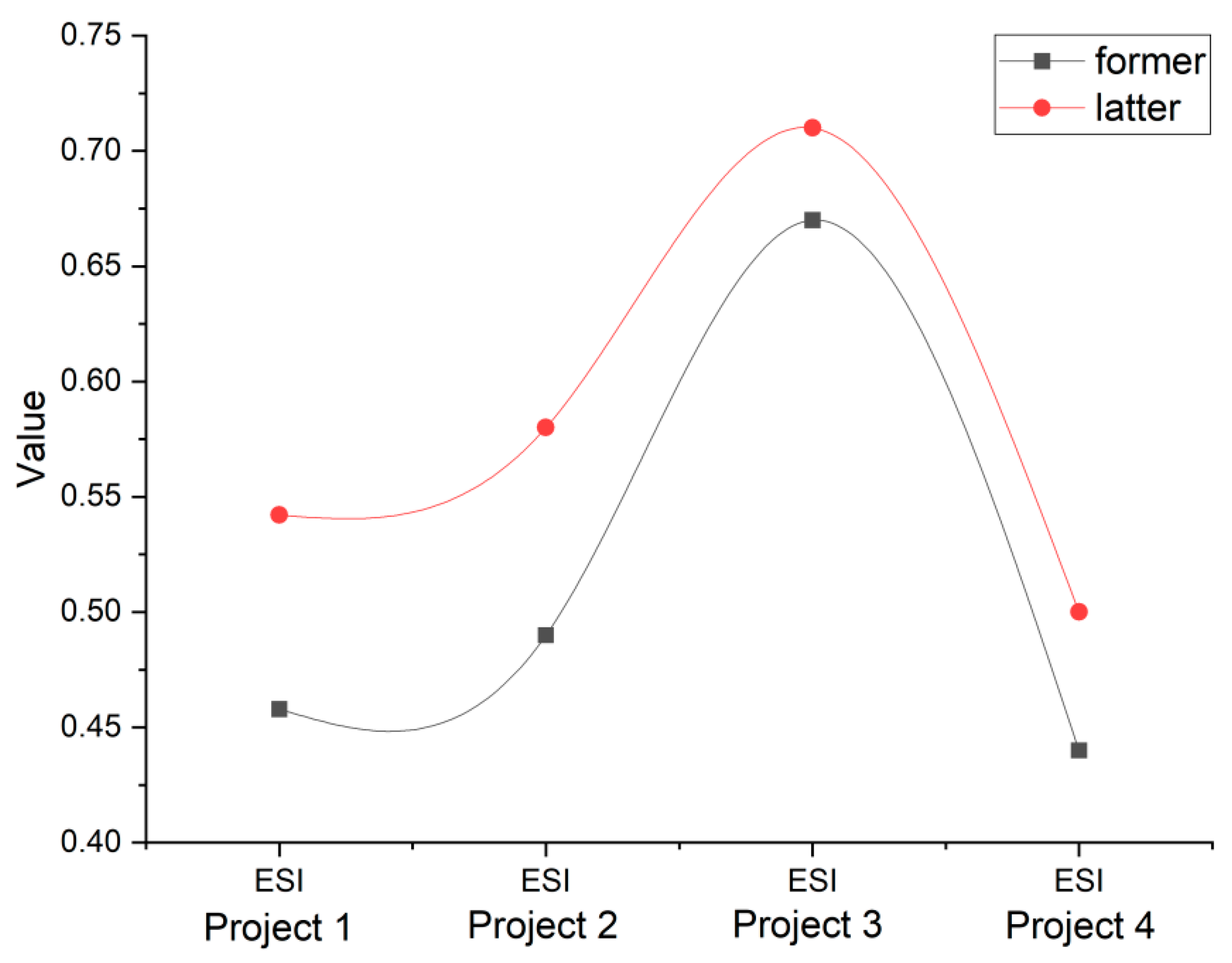
| No. | Indicators | Symbol | Meaning |
|---|---|---|---|
| 1 | Environmental loading ratio | ELR | Natural environmental stress |
| 2 | Emergy yield ratio | EYR | Production efficiency |
| 3 | Emergy sustainability indicator | ESI | Environmental sustainability degree |
| 4 | Unit emergy values | UEVs | Entire system efficiency |
| Name (Branch/River) | Form | Hard Shoreline Proportion | Ecological Shoreline Ratio | Ecological Proportion after Reconstruction |
|---|---|---|---|---|
| Pearl River | Masonry and ecological shoreline | 90% | 10% | 75% |
| Northern section | Masonry and ecological shoreline | 80% | 20% | 75% |
| Eastern section | Masonry and ecological shoreline | 90% | 10% | 75% |
| Middle section | Masonry and ecological shoreline | 85% | 15% | 75% |
| Southern section | Masonry and ecological shoreline | 92% | 8% | 75% |
| Outside the Qinhuai River | Masonry and ecological shoreline | 50% | 50% | 75% |
| Qingxi River | Masonry and ecological shoreline | 90% | 10% | 75% |
| Yudai River | Masonry and ecological shoreline | 95% | 5% | 75% |
| East Jade Belt River | Masonry and ecological shoreline | 93% | 7% | 75% |
| West Jade Belt River | Masonry and ecological shoreline | 93% | 7% | 75% |
| Mingyu River | Masonry and ecological shoreline | 85% | 15% | 75% |
| Binhu district | Masonry and ecological shoreline | 95% | 5% | 75% |
| No. | Indicators | Values |
|---|---|---|
| Original state | ||
| 1 | Emergy yield ratio (EYR) | 26.1 |
| 2 | Environmental loading ratio (ELR) | 357.9 |
| 3 | Emergy sustainability indicator (ESI) | 0.073 |
| Reconstruction project 1 | ||
| 4 | Emergy yield ratio (EYR) | 39.6 |
| 5 | Environmental loading ratio (ELR) | 79.3 |
| 6 | Emergy sustainability indicator (ESI) | 0.49 |
| Reconstruction project 2 | ||
| 7 | Emergy yield ratio (EYR) | 57.8 |
| 8 | Environmental loading ratio (ELR) | 143.2 |
| 9 | Emergy sustainability indicator (ESI) | 0.41 |
| Reconstruction project 3 | ||
| 10 | Emergy yield ratio (EYR) | 64.9 |
| 11 | Environmental loading ratio (ELR) | 96.9 |
| 12 | Emergy sustainability indicator (ESI) | 0.67 |
| Reconstruction project 4 | ||
| 13 | Emergy yield ratio (EYR) | 48.3 |
| 14 | Environmental loading ratio (ELR) | 109.5 |
| 15 | Emergy sustainability indicator (ESI) | 0.44 |
| No. | Indicators | Former Value | Hypothesis H1 | Hypothesis H2 |
|---|---|---|---|---|
| Latter Value | Latter Value | |||
| Original state | ||||
| 1 | EYR | 26.1 | 28.8 | 26.3 |
| 2 | ELR | 357.9 | 369.3 | 336.9 |
| 3 | ESI | 0.073 | 0.077 | 0.078 |
| Reconstruction project 1 | ||||
| 4 | EYR | 39.6 | 43.3 | 39.5 |
| 5 | ELR | 79.3 | 83.2 | 75.9 |
| 6 | ESI | 0.49 | 0.52 | 0.520 |
| Reconstruction project 2 | ||||
| 7 | EYR | 57.8 | 61.9 | 56.5 |
| 8 | ELR | 143.2 | 141.7 | 129.3 |
| 9 | ESI | 0.41 | 0.44 | 0.437 |
| Reconstruction project 3 | ||||
| 10 | EYR | 64.9 | 66.4 | 60.6 |
| 11 | ELR | 96.9 | 128.2 | 117.0 |
| 12 | ESI | 0.67 | 0.52 | 0.518 |
| Reconstruction project 4 | ||||
| 13 | EYR | 48.3 | 54.3 | 49.5 |
| 14 | ELR | 109.5 | 110.6 | 100.9 |
| 15 | ESI | 0.44 | 0.49 | 0.491 |
| Item | Data | Unit | Carbon Emission Factors | Carbon Emission | Unit |
|---|---|---|---|---|---|
| Steel | 7.10 × 104 | kg | 2.67 tCO2/t | 189.6 | tCO2 |
| Cement | 3.80 × 105 | kg | 0.07 tCO2/t | 26.6 | tCO2 |
| Gravel | 8.10 × 106 | kg | 16 kgCO2/kg | 129,600 | tCO2 |
| Brick | 4.10 × 104 | kg | 0.24 kgCO2/kg | 9.8 | tCO2 |
| Lime | 7.20 × 105 | kg | 0.44 tCO2/t | 316.8 | tCO2 |
| Sand | 5.20 × 106 | kg | 2.51 kgCO2/t | 13,052.0 | tCO2 |
| Water | 6.30 × 108 | m3 | 0.82 kgCO2/m3 | 516,600 | tCO2 |
| Iron | 2.10 × 104 | kg | 2.05 tCO2/t | 43.1 | tCO2 |
| Wood | 6.45 × 106 | kg | 0.31 kgCO2/kg | 1999.5 | tCO2 |
| Polyester | 1.23 × 103 | kg | 72.65tCO2/t | 89.4 | tCO2 |
| Adhesive | 6.51 × 103 | kg | 1.1 kgCO2/kg | 7.2 | tCO2 |
| Bituminous | 9.52 × 103 | kg | 0.04 kgCO2/kg | 0.4 | tCO2 |
| Fly ash | 6.64 × 105 | kg | 0.18 tCO2/t | 119.5 | tCO2 |
| PVC | 6.95 × 103 | kg | 4.79 kgCO2/kg | 33.3 | tCO2 |
| Diesel fuel | 6.68 × 104 | kg | 3.797 tCO2/t | 253.8 | tCO2 |
| No. | Indicators | Former Values | Latter Values |
|---|---|---|---|
| Reconstruction project 1 | |||
| 1 | Emergy yield ratio (EYR) | 39.6 | 39.6 |
| 2 | Environmental loading ratio (ELR) | 79.3 | 68.3 |
| 3 | Emergy sustainability indicator (ESI) | 0.49 | 0.58 |
| Reconstruction project 2 | |||
| 4 | Emergy yield ratio (EYR) | 57.8 | 57.8 |
| 5 | Environmental loading ratio (ELR) | 143.2 | 117.9 |
| 6 | Emergy sustainability indicator (ESI) | 0.41 | 0.49 |
| Reconstruction project 3 | |||
| 7 | Emergy yield ratio (EYR) | 64.9 | 64.9 |
| 8 | Environmental loading ratio (ELR) | 96.9 | 91.4 |
| 9 | Emergy sustainability indicator (ESI) | 0.67 | 0.71 |
| Reconstruction project 4 | |||
| 10 | Emergy yield ratio (EYR) | 48.3 | 48.3 |
| 11 | Environmental loading ratio (ELR) | 109.5 | 97.6 |
| 12 | Emergy sustainability indicator (ESI) | 0.44 | 0.50 |
Disclaimer/Publisher’s Note: The statements, opinions and data contained in all publications are solely those of the individual author(s) and contributor(s) and not of MDPI and/or the editor(s). MDPI and/or the editor(s) disclaim responsibility for any injury to people or property resulting from any ideas, methods, instructions or products referred to in the content. |
© 2023 by the authors. Licensee MDPI, Basel, Switzerland. This article is an open access article distributed under the terms and conditions of the Creative Commons Attribution (CC BY) license (https://creativecommons.org/licenses/by/4.0/).
Share and Cite
Dai, D.; Yao, D.; Gao, Y.; Zhang, J. Sustainability Assessment of Urban Waterscape Belt Ecological Reconstruction Based on LCA–Emergy–Carbon Emission Methodology. Water 2023, 15, 2345. https://doi.org/10.3390/w15132345
Dai D, Yao D, Gao Y, Zhang J. Sustainability Assessment of Urban Waterscape Belt Ecological Reconstruction Based on LCA–Emergy–Carbon Emission Methodology. Water. 2023; 15(13):2345. https://doi.org/10.3390/w15132345
Chicago/Turabian StyleDai, Desheng, Di Yao, Yuchen Gao, and Junxue Zhang. 2023. "Sustainability Assessment of Urban Waterscape Belt Ecological Reconstruction Based on LCA–Emergy–Carbon Emission Methodology" Water 15, no. 13: 2345. https://doi.org/10.3390/w15132345
APA StyleDai, D., Yao, D., Gao, Y., & Zhang, J. (2023). Sustainability Assessment of Urban Waterscape Belt Ecological Reconstruction Based on LCA–Emergy–Carbon Emission Methodology. Water, 15(13), 2345. https://doi.org/10.3390/w15132345







